How are Fire Curtains Made?
The first secret to the success of the fire curtain is the materials that make it. Because a fire curtain has to roll up (a bit like a roller blind), it has to be made of a flexible but robust material.
Fire resistant fibreglass is the main ingredient for the business end of a fire curtain. Fibreglass can be woven with metals to further enhance their resistance to heat and add strength. Notice that we call it fire resistant and not fireproof: that’s not a disclaimer, it’s the truth. The reality is that nothing can be fireproof – given enough heat for enough time, absolutely anything will melt, burn or vaporise. A fire resistant material is simply better at withstanding thermal energy and direct exposure to flame for longer.
At Coopers Fire, we’re always researching and developing new ways of keeping fire at bay for longer and making buildings safer. The materials used in our fire curtains and smoke curtains have been subject to the highest scrutiny and are selected to provide the best possible levels of safety.
Advanced designs are also used in the motorised retraction and dropping mechanism. This mechanism can be hidden away in ceiling cavities or placed in a housing to better suit its surroundings. The mechanism is comparatively small, and the robust, precise engineering inside ensures the curtain will work as intended, should the time come.
A release mechanism lets gravity take over if, for any reason, the motorised control should fail. Fire curtains can be set to descend automatically on a fire alarm being triggered, and set to retract if a false alarm or test has been resolved. Advanced systems can detect areas to isolate, to limit the impact on movement and provide a protected means of escape.
Each configuration depends on the use of the building, its architecture and internal layout – but the principals are always the same: stop fire spreading, let people escape safely and limit damage to the building.
The real science behind the fire curtain isn’t the cutting edge materials or advanced controls and sensors: the science comes from understanding fire and depriving it of what it needs to spread. That effect only comes into play when a fire curtain is deployed.
Compartmentation
We’ve covered compartmentation for fire protection before – it’s a cornerstone of fire safety that exploits our understanding of fire. Compartmentation is typically a form of passive fire protection, meaning it’s “always on”. Passive fire protection includes things like fire doors that seal off and compartmentalise small sections of a building, and fire resistant materials installed directly in place.
Fire curtains are a type of active fire protection – meaning that they respond to the presence of fire. Other types of active fire protection include sprinkler systems, alarms and smoke curtains.
Although they’re an active system, fire curtains are used for compartmentation. In open plan and complex buildings, fire curtains compartmentalise space in the same way that fire doors do. They drop down and seal an area off, containing the fire from floor to ceiling, within the perimeter of the curtain (or curtains).
It seems pretty elementary: put in a barrier and the fire can’t spread as fast – but there’s more to it than that. Fire is starved of oxygen and additional fuel. This can lower the intensity of the fire and improve the efficacy of other systems, like sprinklers. The splitting of a large space into several small spaces helps to insulate each subsequent space from heat damage – keeping important structural elements intact.
All of this can be implemented without affecting architecture, design or intended use – making fire curtains an essential element of modern building design.
Cutting Edge Fire Curtains for Fire Protection
At Coopers Fire, we’ll continue to progress our research and development of fire curtains and fire protection. We’re a leading name in fire protection around the world, and with every stride in science and technology, our commitment to fire safety grows stronger.
get in touch
Contact Us
To find out more, or to enroll in our educational training courses, call us at 02392 454 405 or email us.


